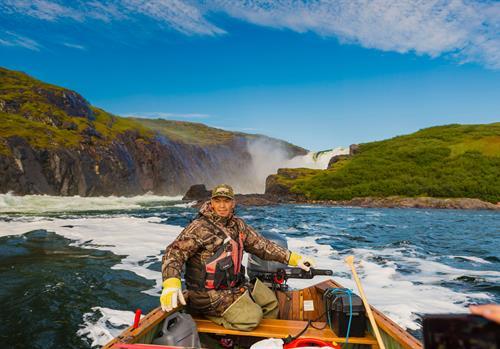Wiyâshâkimî Lake offers an incredible aquatic landscape with scattered hills and islands at the center of the west bassin. Covering 1226km2, the immense lake is the vastest of the park. In Cree, Wiyâshâkimî means clearwater lake. And for good reason: the lake’s transparency is otherworldly. It was created by two meteor impacts on the Hudson plateau that are believed to have occurred 20 million years apart. After thousands of years of human occupation, there are still camps around Lac Wiyâshâkimî.
Its sandy beaches, rocky hills and flat top plateaux make the are a ideal place to explore hiking and fat biking. Our guides will take you by motor boat explore different sectors of the areas. They will show you how to smoke fish and which berries are best to pick for jam and suvalik (a delicacy enjoyed all accross Nunavik).
ITINERARY
Jour 1 | Découverte du village nordique d’Umiujaq
Départ de Montréal vers Umiujaq. Votre expérience au Nunavik débute à bord d’un vol d’Air Inuit en direction d’Umiujaq. À votre arrivée dans cette communauté située aux abords de la baie d’Hudson, vous serez accueillis à l’aéroport par votre guide local qui vous conduira à l’Hôtel-coop. En après-midi, vous visiterez le pavillon d’accueil du parc national Tursujuq pour une mise-au-point sur votre séjour et les mesures de sécurité en prenant le thé. Vous participerez ensuite à une visite guidée du village qui se terminera par un souper à l’Hôtel-coop.

• Repas : Souper à la Coop Hôtel de Umiujaq.
• Hébergement : Hébergement Coop Hôtel d'Umiujaq.
Day 1 |
Day 2 |
Days 5 |
Day 7 |
Jour 6 : Découverte de la majestueuse chute Nastapoka
La journée débutera par une expédition en bateau d'environ une heure qui vous fera longer la baie d'Hudson. Vous partirez à la découverte de la majestueuse chute Nastapoka et de son impressionnante plage de sable où vous passerez la journée. Ce site, connu des Inuit depuis des générations, est un lieu privilégié pour l’observation de mammifères marins et terrestres. Pour vous y rendre, vous voguerez entre les paysages des îles Gillies et les imposantes cuestas hudsoniennes longeant la côte. Une fois à l’embouchure de la rivière Nastapoka, pique-nique, feu de camp, pêche, baignade et courte randonnée vers la chute seront au programme. Vous reviendrez pour le souper à Umiujuaq où vous passerez la nuit.


• Hébergement : Coop Hôtel d'Umiujaq
Jour 9 | Départ de la communauté vers Montréal
Dernier jour de votre périple dans le Grand Nord québécois. Temps libre en avant-midi, dîner au pavillon d’accueil du parc, puis vol de retour vers Montréal.

• Repas : Petit déjeuner à la Coop Hôtel d'Umiujaq.
What Do You Need to Know?
Meals are provided locally, based on traditional cuisine as much as possible, therefore depending on seasonal catches and other available provisions. The meals listed in the itinerary are those normally provided during this expedition. In accordance with northern realities, meals may be adjusted depending on availabilities.
Weather in Nunavik is changing constantly. Expeditions may be adjusted to take into account current conditions. Openness to new situations (such as plane delays or cancelations, changes in the itinerary), flexibility and the ability to adapt to modified activities and agenda are important prerequisites for travelers in Nunavik Parks and an authentic part of your northern experience.
Notes
Price per person, before taxes. All-included (meals, accommodations, transportation). Preferential prices for JBNQA beneficiaries. 2 participants needed to guarantee departure, contact us to join a group. Although hunting and trapping are strictly prohibited into the National Parks of Quebec, Inuit have the right to practise their subsistence activities throughout Nunavik, including the parc national Tursujuq. Thus, witness a group of Inuit hunting caribou, ringed or trapping foxes may be part of the Nunavik park experience.
Safety
All the expeditions led by Tursujuq national park team can be followed day by day through daily satellite positioning. The team can contact the park staff anytime with a satellite phone. It's part of visitors responsibilities to plan their own safety: training to prepare your trip and having the proper insurance is part of it. Therefore, we strongly advise visitors to take an insurance policy covering air evacuation costs.
